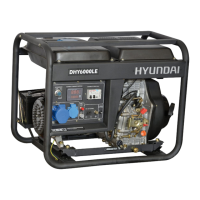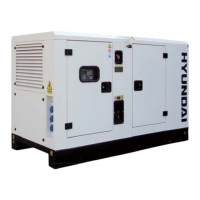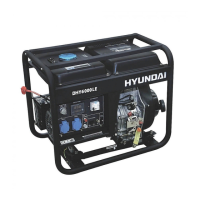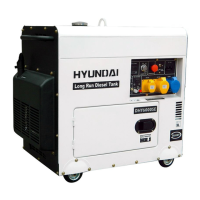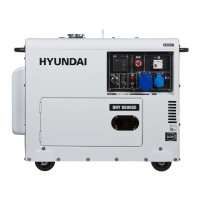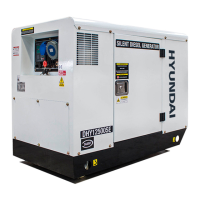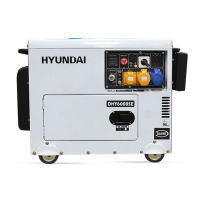Do you have a question about the Hyundai DHY22KSE and is the answer not in the manual?
Safety instructions for lifting and suspending the generating set.
Warnings related to moving parts and operating guards.
Precautions for noise levels and protective clothing.
Warnings regarding fuel, chemicals, and ventilation.
Precautions for electrical connections and grounding.
Overview of HYUNDAI diesel engine generator sets and their applications.
Identification and brief description of major generator set components.
Details on the selection and advantages of HYUNDAI diesel engines.
Features and specifications of HYUNDAI's alternators.
Components of the water-cooled engine cooling system.
Specifications of the engine's 12V or 24V DC electrical system.
Description of the coupling between engine and alternator.
Details on the integrated fuel tank and base frame.
Information on the high-grade control panel and its features.
Features for canopy generator sets.
Description of the external filling hole for antifreeze.
Feature for convenient lubricant discharge and oil change.
Design features for easier hoisting and transportation.
List of other components and optional parts.
Purpose and function of the optional pre-heater.
Importance of correct installation and compliance with regulations.
Guidelines for safe shipment, securing, loading, and unloading.
Requirements for foundation hardness, stability, and dimensions.
Considerations for designing the working room, including ventilation and exhaust.
Instructions for locating and fixing the generator set on its foundation.
Guidance on placing and securing the generator set using vibration reduction units.
Principles and design considerations for optimal air intake and exhaust.
Design aspects for the exhaust system, including silencers and soft connections.
Design considerations for the exhaust system, including silencers and soft connections.
Importance of noise reduction to meet standards and minimize environmental impact.
Requirements for coolant quality, properties, and mixing.
Procedures and recommended intervals for changing the coolant.
Steps for cleaning the cooling system.
Instructions for adding coolant to the system, including air bleeding.
Typical fuel oil specifications and property definitions.
Specifications and requirements for the base frame fuel tank.
Guidelines for positioning the fuel tank and ensuring proper fuel head.
Factors affecting fuel consumption and quality requirements.
Guidelines for selecting and installing flexible power cables.
Requirements for connecting the generator set frame to earth ground.
Procedures for testing insulation resistance before starting.
Pre-operation checks required before starting the generator set.
Procedures for pre-heating, connecting to power, and starting the generator.
Decision criteria and procedure for pre-heating the engine.
Steps to connect the control panel to the power supply.
Instructions for starting the engine using the start button or auto-start.
Monitoring parameters during generator set operation.
Procedure for immediate shutdown in case of severe malfunction.
Procedure for safely stopping the generator set under normal conditions.
Post-operation checks and actions after stopping the generator set.
Importance and content of recording running parameters and maintenance.
Important warnings and precautions during operation and maintenance.
Step-by-step guide for operating the generator control panel.
Introduction to the electronic control system and its modules.
Explanation of control panel buttons, LEDs, and their functions.
Detailed modes of operation (OFF, MAN, AUTO) and alarm handling.
Overview of the AMF10/16 control module features and differences.
Introduction to the Automatic Transfer Switch (ATS) panel for standby power.
Steps for operating the ATS panel in manual mode.
How to connect and set the generator module for automatic operation.
Importance of periodic maintenance and following manuals.
Maintenance schedule for engine checks at various running hours.
Procedures for cleaning and maintaining the alternator.
Daily maintenance tasks for the control panel.
Maintenance and charging procedures for the start battery.
Importance of completing and maintaining maintenance records.
Overview of common malfunctions and their causes, emphasizing user practices.
A checklist to help identify and troubleshoot generator set malfunctions.
Formulas for calculating amps, horsepower, kilowatts, and kVA.
Table of weights and specific gravities for common liquids.
Data on bearing load capabilities of various foundation materials.
Safety instructions for lifting and suspending the generating set.
Warnings related to moving parts and operating guards.
Precautions for noise levels and protective clothing.
Warnings regarding fuel, chemicals, and ventilation.
Precautions for electrical connections and grounding.
Overview of HYUNDAI diesel engine generator sets and their applications.
Identification and brief description of major generator set components.
Details on the selection and advantages of HYUNDAI diesel engines.
Features and specifications of HYUNDAI's alternators.
Components of the water-cooled engine cooling system.
Specifications of the engine's 12V or 24V DC electrical system.
Description of the coupling between engine and alternator.
Details on the integrated fuel tank and base frame.
Information on the high-grade control panel and its features.
Features for canopy generator sets.
Description of the external filling hole for antifreeze.
Feature for convenient lubricant discharge and oil change.
Design features for easier hoisting and transportation.
List of other components and optional parts.
Purpose and function of the optional pre-heater.
Importance of correct installation and compliance with regulations.
Guidelines for safe shipment, securing, loading, and unloading.
Requirements for foundation hardness, stability, and dimensions.
Considerations for designing the working room, including ventilation and exhaust.
Instructions for locating and fixing the generator set on its foundation.
Guidance on placing and securing the generator set using vibration reduction units.
Principles and design considerations for optimal air intake and exhaust.
Design aspects for the exhaust system, including silencers and soft connections.
Design considerations for the exhaust system, including silencers and soft connections.
Importance of noise reduction to meet standards and minimize environmental impact.
Requirements for coolant quality, properties, and mixing.
Procedures and recommended intervals for changing the coolant.
Steps for cleaning the cooling system.
Instructions for adding coolant to the system, including air bleeding.
Typical fuel oil specifications and property definitions.
Specifications and requirements for the base frame fuel tank.
Guidelines for positioning the fuel tank and ensuring proper fuel head.
Factors affecting fuel consumption and quality requirements.
Guidelines for selecting and installing flexible power cables.
Requirements for connecting the generator set frame to earth ground.
Procedures for testing insulation resistance before starting.
Pre-operation checks required before starting the generator set.
Procedures for pre-heating, connecting to power, and starting the generator.
Decision criteria and procedure for pre-heating the engine.
Steps to connect the control panel to the power supply.
Instructions for starting the engine using the start button or auto-start.
Monitoring parameters during generator set operation.
Procedure for immediate shutdown in case of severe malfunction.
Procedure for safely stopping the generator set under normal conditions.
Post-operation checks and actions after stopping the generator set.
Importance and content of recording running parameters and maintenance.
Important warnings and precautions during operation and maintenance.
Step-by-step guide for operating the generator control panel.
Introduction to the electronic control system and its modules.
Explanation of control panel buttons, LEDs, and their functions.
Detailed modes of operation (OFF, MAN, AUTO) and alarm handling.
Overview of the AMF10/16 control module features and differences.
Introduction to the Automatic Transfer Switch (ATS) panel for standby power.
Steps for operating the ATS panel in manual mode.
How to connect and set the generator module for automatic operation.
Importance of periodic maintenance and following manuals.
Maintenance schedule for engine checks at various running hours.
Procedures for cleaning and maintaining the alternator.
Daily maintenance tasks for the control panel.
Maintenance and charging procedures for the start battery.
Importance of completing and maintaining maintenance records.
Overview of common malfunctions and their causes, emphasizing user practices.
A checklist to help identify and troubleshoot generator set malfunctions.
Formulas for calculating amps, horsepower, kilowatts, and kVA.
Table of weights and specific gravities for common liquids.
Data on bearing load capabilities of various foundation materials.
| Model | DHY22KSE |
|---|---|
| Type | Portable Generator |
| Max. Power (kW) | 22 |
| Rated Power (kW) | 20 |
| Frequency (Hz) | 50 |
| Fuel Type | Diesel |
| Fuel Tank Capacity (L) | 25 |
| Starting System | Electric Start |
| Run Time | 12 hours |
| Engine Type | 4-Stroke, Air-Cooled |
